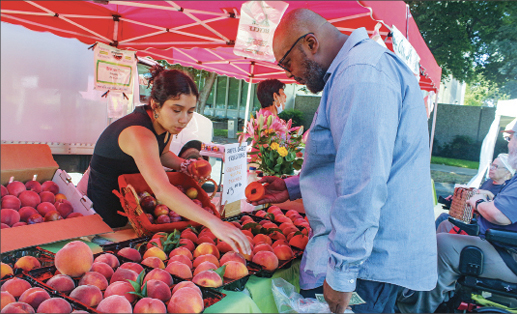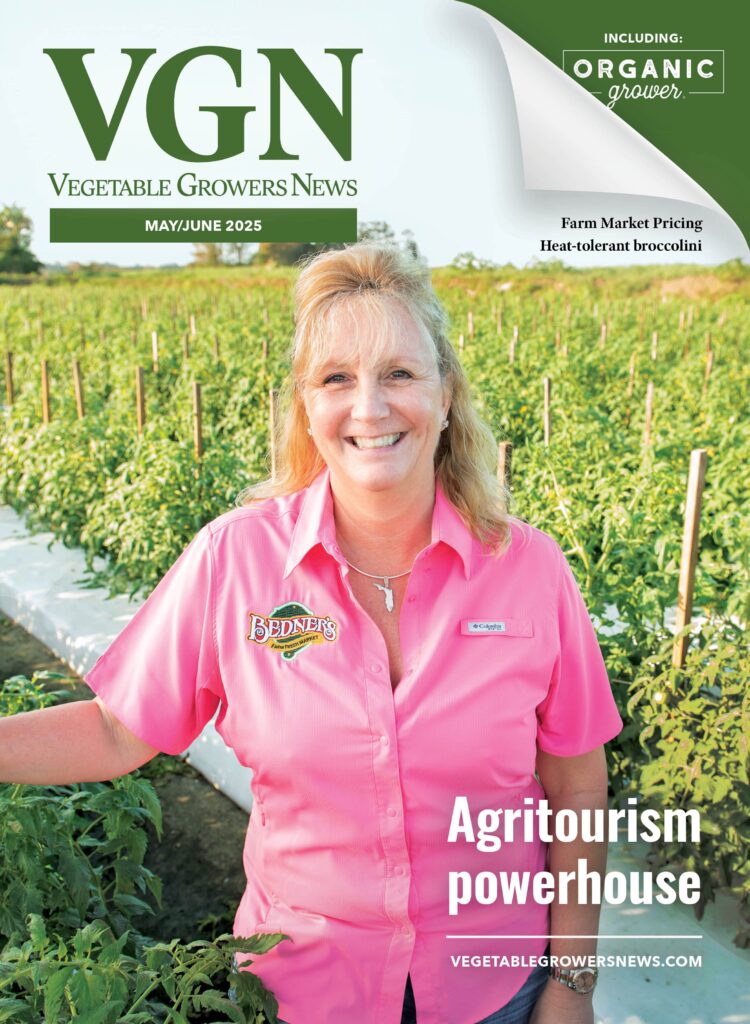Jul 21, 2021Farmers’ markets seeing uneven recovery in California
Farmers’ markets have long drawn thousands of shoppers during peak summer season for many crops. But growers say the pandemic upset that trend and its impacts linger, even as markets ease COVID-19 restrictions and try to return to some normalcy.
The pandemic forced some California farmers’ markets to close temporarily last year at the height of the state lockdown. Though many markets reopened after putting in place safety protocols, others stayed closed and have not reopened. Some markets saw attendance drop as distancing requirements and other restrictions led to long lines, increased wait times and fewer transactions, farmers reported.
Now that restaurants are allowed to open to full capacity, farmers say they’re beginning to see more of their food-service customers coming back to the markets. But with so many people still working from home, weekday markets that depend on their patronage continue to struggle with lighter foot traffic.
Vendors at the Capitol Mall Farmers Market in downtown Sacramento say they have yet to see the pre-COVID lunch crowds that used to keep the seasonal market bustling.
Dan Best, coordinator of Certified Farmers Markets of Sacramento County, which operates the market, estimated about 20% of offices in the area are being occupied.
“It’s a ghost town,” he said. “There’s no one downtown. You can’t bring the farmers down there just for an exhibition.”
To be profitable, pedestrian markets such as Capitol Mall need “a lot of transactions,” Best said. He noted that three “thriving” downtown farmers markets, which saw heavy foot traffic, closed last year and won’t reopen this year because “they were based upon full-capacity office buildings.” He said he was uncertain whether the Capitol Mall market would reopen “because it was so lousy last year.”
A few restaurant customers “saved it” for some vendors, he said, so the market this year is promoting itself as a “chef’s market” to draw more food-service business. Even though the lunch crowd downtown remains “meager,” he noted chefs are shopping at the market again.
Ingar Russ of Loving Nature Farm in Clarksburg said it helps that the market is trying to accommodate chefs by providing them convenient parking and carts to load up. She pointed to Juan Barajas, who runs Savory Café in Woodland and who had stopped by her booth. Barajas said it’s been easier for him to shop at Capitol Mall because vendors allow him to buy in bulk – and they give him a chef’s discount.
Though chefs are returning, Nick Barnett, who works for Vierra Farms in West Sacramento, said the market’s main customers are people who stroll down from office buildings during lunch. They tend to buy only what they can carry, he said. That’s why he changed to pre-bagging more items this year and selling them at a flat price rather than by the pound, which “generally doesn’t sell here,” he said.
“I try to make it super easy, just implementing certain marketing strategies to combat the lack of traffic around here,” Barnett said.
A San Francisco nonprofit, which operates several farmers markets in the city, including the Ferry Plaza Farmers Market, said its Saturday and Thursday evening markets are now about 90% of pre-pandemic levels, though weekday markets feel closer to 60%.
The Ferry Building used to get foot traffic from three reliable populations—Financial District workers, tourists and chefs – “that are only slowly coming back,” said Christine Ferran, executive director of Center for Urban Education about Sustainable Agriculture. Its Tuesday and Thursday markets were always “really robust,” she said. Before, people were not only coming to the farmers market but also shopping inside the Ferry Building. Some of those shops closed during the pandemic, she noted, “so the building is less of a draw right now.”
“Death by a thousand cuts: There’s a lot of different reasons why our weekday markets are not coming back as robustly, but we know the No. 1 reason is office employees still working from home,” Farren said.
Also absent are the more than 3,000 students who used to come through the market on their field trips or for cooking classes, she said. But she noted the San Francisco Unified School District has said it plans to return to in-person learning in August. Even so, she said it remains unclear what the policy will be on field trips.
Other activities that have not returned to the market include sampling and cooking demos, Farren said. The market has continued its online ordering platform, which redirected sales lost from restaurants, she said. During the pandemic, CUESA started its own curated farmers’ market box for people who didn’t feel comfortable shopping in person. The organization has since partnered with The FruitGuys in San Francisco – which specialized in delivering fresh fruit to businesses prior to the pandemic – to run its e-commerce site and make food-box deliveries.
With her mangos just now coming into season, Riverside County farmer Debbie Chamberlain said business at the three Pasadena farmers markets she attends has been “as good as ever.” She sold out of fruit within hours of opening. Even though she experienced “major drops” in sales to restaurants last year, she said, they were offset by more people coming to the markets due to restaurants being closed and people cooking more at home. Now that the market is not requiring people to line up, traffic is more efficient and customers are “willing to come more often,” she said. That includes some of her regulars who are seniors and who had stopped coming to the markets last year due to fears of the virus. They’re now back.
Farmers’ market attendance may have picked up, but Santa Barbara County rancher and egg producer Steve Zaritsky said the people who come are now a different crowd. He’s lost many of his regulars who could afford his products – and who used to come with entire shopping lists.
“Now we get a lot of looky-loos,” he said. “You see people walking around with nothing in their arms – no bags, no carts, no nothing – and they stop by just to see what’s this and what’s that.”
Before the pandemic, Zaritsky was attending 18 Southern California farmers markets and earning $15,000 a week. He’s now bringing in about $1,400 from two markets. Some markets have closed, he noted, and staffing them has been a challenge due to a lack of sales. Though he’s added some food-service accounts, Zaritsky said convincing restaurants that are trying to get back on their feet to buy his organic eggs at more than four times the price of conventional eggs has been “almost an impossible feat.”
“It’s been a really crazy roller coaster ride,” he said. “I’m just trying to make sure I get enough money to feed the animals when everybody wants their money.”
– Ching Lee, California Farm Bureau Federation

















